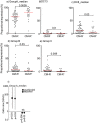Differential Plasmodium falciparum surface antigen expression among children with Malarial Retinopathy
- PMID: 26657042
- PMCID: PMC4677286
- DOI: 10.1038/srep18034
Differential Plasmodium falciparum surface antigen expression among children with Malarial Retinopathy
Abstract
Retinopathy provides a window into the underlying pathology of life-threatening malarial coma ("cerebral malaria"), allowing differentiation between 1) coma caused by sequestration of Plasmodium falciparum-infected erythrocytes in the brain and 2) coma with other underlying causes. Parasite sequestration in the brain is mediated by PfEMP1; a diverse parasite antigen that is inserted into the surface of infected erythrocytes and adheres to various host receptors. PfEMP1 sub-groups called "DC8" and "DC13" have been proposed to cause brain pathology through interactions with endothelial protein C receptor. To test this we profiled PfEMP1 gene expression in parasites from children with clinically defined cerebral malaria, who either had or did not have accompanying retinopathy. We found no evidence for an elevation of DC8 or DC13 PfEMP1 expression in children with retinopathy. However, the proportional expression of a broad subgroup of PfEMP1 called "group A" was elevated in retinopathy patients suggesting that these variants may play a role in the pathology of cerebral malaria. Interventions targeting group A PfEMP1 may be effective at reducing brain pathology.
Figures



References
-
- Lewallen S. et al. Clinical-histopathological correlation of the abnormal retinal vessels in cerebral malaria. Arch Ophthalmol 118, 924–928 ecs90324 (2000). - PubMed
Publication types
MeSH terms
Substances
Grants and funding
LinkOut - more resources
Full Text Sources
Other Literature Sources
Medical

